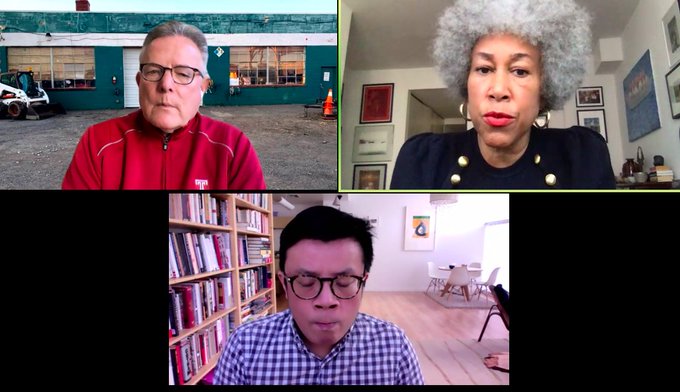You don’t need to work in the field to know or care that, as with so many industries, 2020 hit journalism hard. Reporters are tasked with covering societal inequities and economic downturns while feeling the impact of those same challenges.
This year’s Klein News Innovation Camp, hosted over Zoom on Saturday, Nov. 14, was a master class in journalism solutions. Hosted annually by Technical.ly and Temple University’s Klein College of Media and Communications, the conference fostered significant discussions about ethics, newsroom diversity and financials, and the future of news between about 50 attendees sitting in front of their web cameras.
So what was discussed, and what does it mean for news consumers?
Moral clarity and journalism
In this first panel, Vice News reporter Alexis Johnson, CBS News reporter Wesley Lowery and American Press Institute Executive Director Tom Rosenstiel spoke about what it means to be “objective” while reporting.
“The term ‘objectivity’ came into use in journalism in the early 20th century at a time not unlike the one we’re in now,” Rosenstiel said. “What they meant by objectivity is more transparency, more rigor, more discipline to show how you do your work. It did not mean neutrality.”
Johnson came to Vice News once she was removed from covering Black Lives Matter protests for the Pittsburgh Post-Gazette after posting a tweet comparing the damage done by looters to the trash left after a country concert.
“I got called into this national conversation about what objectivity means,” Johnson said. “What is bias when you’re talking about reporters? Are there two sides? Are there two sides to racism, especially if we’re talking about Black Lives Matter all summer? What side should we be on? Is it biased to say ‘Black lives matter,’ because that means supporting a political movement? Or are we talking about human rights?”
Lowery concluded that journalists should accept their own biases and use that knowledge to ask more well-rounded questions and write more objective stories.
“If you just insist that you are a journalism robot with no bias, suddenly you have no cause to do those things,” he added. “I would argue that we end up seeing a lot of journalism that ends up biased by the author, the reporter, the correspondent, because of their own personal insistence that they have no bias.”
Beat reporting
Chalkbeat cofounder Elizabeth Green, Generocity Editor Sabrina Vourvoulias, and Technically Media CEO Christopher Wink spoke about what the growing existence of niche publications (such as this very site) means for journalism.
“We have to meet people where they are,” said Green, whose Chalkbeat reports on education. “There could be multiple publishers producing content. But from the consumer point of view, sometimes you’re going to want to read a lot about one topic, and you’re going to be a really close member of that community.”
She and Wink spoke about multi-location beat-specific news organizations, as Chalkbeat reports from seven bureaus across the nation, while Technical.ly, focused on economic growth and technology, reports primarily from four East Coast markets.
Vourvoulias, who worked at a number of niche news organizations before coming to Generocity, said beat-focused organizations create more opportunities for in-depth understanding and quality community reporting than large-scale publications.
“Community news organizations really are good at dissolving the idea of monoliths of any sort,” she added.
WTF 2020
In perhaps the most all-encompassing panel at the conference, Marsha Cooke, SVP of impact for Vice News, Sewell Chan, editorial page editor for the Los Angeles Times, and Klein College Dean David Boardman discussed the struggles journalists face in 2020.
The conversation spanned COVID-19, racial injustice and the impact of the phrase “fake news.”
“The real problem of this year is that we have to focus on journalists’ wellbeing and health,” Chan said. “PTSD is a real thing. Trauma is a real thing. We know it’s not going to end soon.”
Boardman touched upon Klein College’s efforts to support young journalists during a year in which journalism has confronted open hostility, while Cooke emphasized that COVID-19 has forced news organizations to reconsider how they operate.
“You’re ready for an earthquake, but no one’s thought about that kind of preparedness when thinking about an office for the pandemic,” she said. “What I think we are missing is that one-on-one contact, or that Monday morning family meeting. I think we lose a great deal by not having that ability to be in that room together. This is great, but it is isolating, and frankly, very lonely.”
News organizations and earned income
As the economic fallout from COVID-19 exacerbates an already struggling financial outlook for media companies, The Washington Post’s Margaret Sullivan, Solutions Journalism Network’s Liza Gross and Newsonomics’ Ken Doctor discussed ways to keep the industry stable.
“People will pay for sufficient, unique, knowledgeable content,” Doctor said. “So the question is, how do we apply this now? We have an opportunity to understand in 2020 that the audiences are much different. This is a purely digital decade. And the solutions are well within sight.”
Gross spoke about the variety of revenue-generating models in use at news organizations from the Texas Tribune to Spain’s El País.
Some of those revenue-generating forms, like paywalls, have been criticized for the way they limit which audiences have access to news, but Sullivan offered a different perspective.
“I posted my most recent column as I always do on Twitter and one of the replies was, ‘Bummer, I hit a paywall,’” she said. “But I thought I might start saying, ‘Yes, it’s called a paywall, because it’s how journalists get paid.’”
More diverse newsrooms
The final panel of the conference was a discussion on how to add diverse staff to newsrooms between Klein College’s Lu Ann Cahn, WHYY’s Sandra Clark and Report for America’s Steven Waldman.
“I’m optimistic about diversity, because I feel like I’ve seen in the last few years employers wake up,” Cahn said. “I’m concerned, however, about this next generation and keeping some great talent in the field of journalism. I see a lot of fear about going into this business for a number of reasons.”
These fears, which the panelists said include financial stability, the lack of diverse support in newsrooms and an insufficient pipeline to journalism for people of color, still need to be solved before diversity will be achieved inside news organizations.
“[Newsrooms] are putting way too much burden on this reporter to solve all of their problems,” Waldman said. “There’s a lack of representation, or all these communities that have been covered horribly for 75 years, and you’re putting this reporter in there and expecting that reporter to regain the trust of that community.”
The panel concluded that newsroom training, more paid opportunities for aspiring reporters of color and hiring diverse journalists for their community understanding rather than the diversity box that they check are some steps to solutions news organizations can take.
“The whole diversity picture is much more than a person,” Clark said. “It’s really a mindset.”
Join our growing Slack community
Join 5,000 tech professionals and entrepreneurs in our community Slack today!
Donate to the Journalism Fund
Your support powers our independent journalism. Unlike most business-media outlets, we don’t have a paywall. Instead, we count on your personal and organizational contributions.

Half of Pennsylvania’s federal buildings are set to be sold under Trump admin plan

RealLIST Startups 2025: Meet 20 Philly startups hot on the track to success

RealLIST Startups 2025: 16 early-stage Pittsburgh companies poised to make a difference


